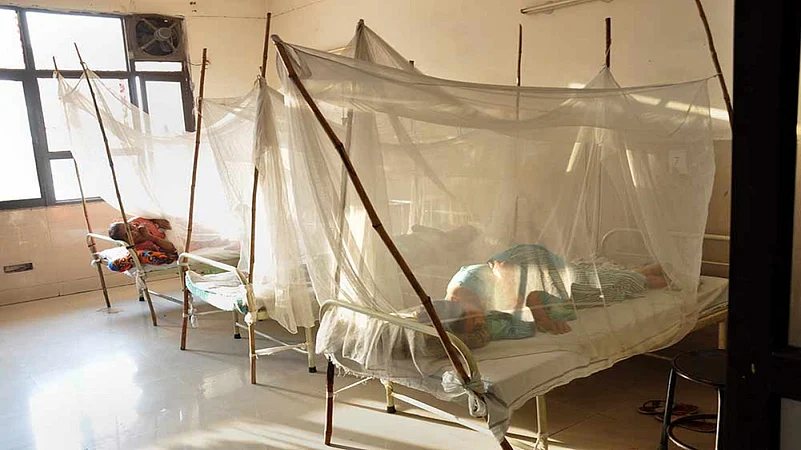India set an ambitious target of ending malaria by 2030 with the launch of the National Framework for Malaria Elimination in 2016.?However, despite being a notifiable disease, very few entities in the private sector report malaria prevalence riddling the path to malaria elimination with several roadblocks.?
NGOs Play Crucial Role In Supporting Private, Public Sectors Toward Malaria Elimination
The fight to end malaria requires an?active engagement of both the public and the private sectors as well as policymakers, communities, and individuals. Non-governmental organisations and not-for-profit groups also have a significant role to play towards the achievement of this goal.

Insufficient surveillance,?slow and disaggregated reporting especially in the border areas and places inhabited by high-risk groups, and the lack of complete data on malaria impair the ability to fight the disease. Following this, entities, fighting to eliminate the disease, are unable to take adequate corrective measures and implement preventive programmes and policies holistically.
The fight to end malaria requires an?active engagement of both the public and the private sectors as well as policymakers, communities, and individuals. Non-governmental organisations and not-for-profit groups also have a significant role to play towards the achievement of this goal.
Pratik Kumar, Country Director, Malaria No More, tells, "Social and non-profit organisations can act as a crucial link in the public-private partnership model. Most non-profits have strong community connections and have a proven track record of working with Central and state governments to create impact at scale."
Malaria No More is a non-profit organisation that?has been supporting various state governments as well as the Centre. Apart from taking other measures, they are working in tandem to help other states adopt, document, and scale new technologies and locally supported strategies that demonstrated results.
At large, malaria has been?perceived as a poor man’s disease, and, therefore, it gets low priority in the public health agenda. But non-profits working on the ground have a chance to turn that around and address the hidden burden of the disease.
Emphasizing the same, Kumar says,?"The under-reporting of malaria cases owing to lack of screening hinders the fight to end the disease. However, public and private stakeholders with the help of NGOs can drive access to diagnosis and treatment of patients with malaria and promote prevention using insecticide-treated nets, Indoor Residual as well as Intermittent Preventive Treatment of Malaria for Pregnant Women and intermittent preventive treatment of malaria in infancy to reduce the spread of the illness as well as deaths."
Kumar highlights that while development cooperation can limit the spread of malaria,?non-profit organisations can focus on spreading knowledge of solutions and promoting best practices in endemic areas.
He further explains that organisations working at the grassroots often help facilitate effective and open communication between various stakeholders and target groups. "Civil society, non-government and community organisations need to spearhead initiatives. They can make a profound difference with their extensive reach and large volunteer base to propel public-private initiatives in the health sector through disease prevention programmes," he adds.?
Organisations should perhaps begin by looking at low-cost, high-impact models which can be replicated in the PPP model. Starting with smaller projects and driving success for the same can help build credibility and get buy-in from the stakeholders.
Kumar adds, "We must curate a consultative approach – create a working group representing all sectors on key national programmes. The way forward to this is the need for engagement and partnership. A private-public model will bring in resources that the government needs to make healthcare available, as well as create a sustainable long-term model. It can improve the healthcare system by pooling the expertise and finances of the private sector with the access and subsidies of the public sector."
Citing?a?case in point, Kumars explains how?Odisha, a state with the highest malaria burden, has made innovations and reduced malaria cases by more than 80 per cent?between 2017 and 2018 and emerged as the leader in saving lives and reducing malaria cases, along with its toll on rural health systems. "Odisha’s progress serves as a model for other high malaria-burden states and regions," he adds.?
India is soon approaching the end of the current National Strategic Plan, and thus needs to start conceptualising and initiating strategic discussions and cross-sectoral discourse on critical advocacy and technical issues to craft a robust Endgame National Strategic Plan for 2022-2027. It will be critical to achieving zero indigenous transmission of Malaria in India by 2027 and sustaining zero transmission for three years until 2030, a requirement essential for receiving the Certification of Malaria Elimination from the World Health Organization. This demands urgent action and active participation from all stakeholders.
- Previous Story
 Elections 2024: Ashok Tanwar Joins Congress Again; Sehwag Endorses Congress Candidate In Haryana
Elections 2024: Ashok Tanwar Joins Congress Again; Sehwag Endorses Congress Candidate In Haryana - Next Story
























